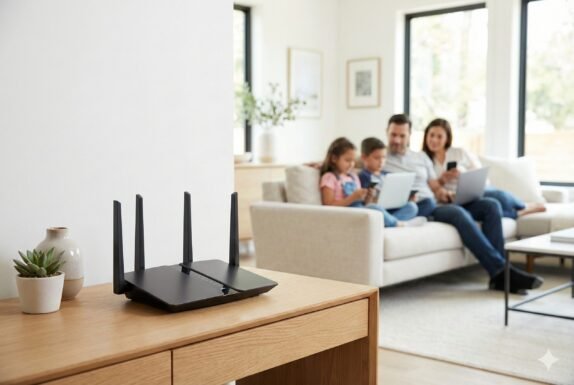Top 5 Best Household Routers 2025
If your home Wi-Fi keeps dropping or slowing down, you’re in the right place. Finding one of the best household routers can fix this, ensuring you get the speed, range, and reliability you’re paying for, even with many devices connected at once.
This guide reviews the top models chosen for their speed, range, reliability, and real user feedback. We’ll cover everything from solid Wi-Fi 6 upgrades and secure travel routers to the latest Wi-Fi 7 models, helping you find the perfect fit for your home network.
Table of Contents
At a Glance: Top 5 Best Household Routers
| Product Name | Key Features | Ideal Use |
|---|---|---|
| TP-Link Archer AXE75 | Wi-Fi 6E, Tri-Band (6 GHz), OneMesh | Future-proofing on a budget (small-medium homes). |
| TP-Link Archer AX3000 | Wi-Fi 6, Dual-Band, Mature Firmware | Solid, reliable upgrade for most homes. |
| GL.iNet GL-SFT1200 | AC1200, OpenWRT, VPN Support | Secure travel and remote work. |
| TP-Link Archer BE550 | Wi-Fi 7, Tri-Band, 2.5 Gbps Ports, MLO | Maximum performance & future-proofing. |
| TP-Link TL-WR1502X | Wi-Fi 6, Ultra-Portable, USB-C Power | Ultra-portable travel & mobile tethering. |
Top 5 Best Household Routers 2025
🥇1. TP-Link Archer AXE75 Tri-Band Router
Use Case / Strength: This router is the ideal entry point into Wi-Fi 6E, offering access to the uncongested 6 GHz band without a premium price tag. It’s a compelling balance for future-proofing everyday utility in small to medium-sized homes, providing solid performance and the ability to expand with OneMesh extenders.
- Wi-Fi 6E Tri-Band:** Supports 2.4 GHz, 5 GHz, and the newer 6 GHz band for combined speeds up to 5,400 Mbps.
- 1.7 GHz Quad-Core CPU:** Provides a powerful processor to manage heavy network traffic and multiple devices.
- OneMesh Compatible:** Allows you to create a flexible mesh Wi-Fi network by adding TP-Link extenders for seamless whole-home coverage.
- USB 3.0 Port:** Enables fast media sharing or connecting external storage directly to your network.
- HomeShield Security:** Includes TP-Link’s built-in security suite for network protection.
🥈2. TP-Link Archer AX3000
Use Case / Strength: This is a solid, reliable upgrade for households that want better-than-AC performance without the cost of Wi-Fi 6E. It’s an attractive balance of mature firmware, good stability, and improved efficiency for typical family use with multiple streaming and smart home devices.
- Wi-Fi 6 Performance:** Offers speeds up to 2,400 Mbps on the 5 GHz band and 574 Mbps on the 2.4 GHz band.
- OFDMA & MU-MIMO:** Improves efficiency and allows the router to communicate with multiple devices simultaneously, reducing lag.
- Cost-Effective Upgrade:** Provides a significant speed boost over older AC routers at a more accessible price point than 6E or 7.
- Stable & Mature:** A great choice for users who prioritize reliability and proven technology for their main household router.
🥉3. GL.iNet GL-SFT1200
Use Case / Strength: This compact router is built for travelers, remote workers, or anyone needing a secure connection on the go. Its key strength is running OpenWRT, giving you advanced control and built-in VPN support for bridging public Wi-Fi securely at a hotel or coffee shop.
- OpenWRT & VPN Support:** Comes pre-installed with OpenWRT and built-in clients for WireGuard and OpenVPN.
- AC1200 Dual-Band:** Provides reliable AC speeds (approx. 300 Mbps on 2.4 GHz + 867 Mbps on 5 GHz).
- Gigabit Ports:** Includes gigabit LAN and WAN ports, which is excellent for a router this size.
- Multiple Modes:** Can be used as a router, access point, repeater, or client for maximum flexibility.
- Secure Bridging:** Safely connect all your devices to a public Wi-Fi network through one secure tunnel.
🏅4. TP-Link Archer BE550
Use Case / Strength: The BE550 is for users who want to future-proof their home for years and break past the 1-gigabit bottleneck. Its Wi-Fi 7 technology and 2.5 Gbps ports provide maximum headroom for demanding devices like VR/AR, 8K streaming, and network-attached storage (NAS).
- Wi-Fi 7 Tri-Band:** Utilizes the 2.4, 5, and 6 GHz bands with a theoretical aggregate throughput of 9,214 Mbps.
- Five 2.5 Gbps Ports:** Includes one 2.5G WAN and four 2.5G LAN ports to eliminate wired bottlenecks.
- Multi-Link Operation (MLO):** A key Wi-Fi 7 feature that reduces latency and increases throughput by using multiple bands at once.
- 320 MHz Channel Widths:** Supports ultra-wide channels for significantly faster speeds on compatible devices.
- EasyMesh Support:** Can be integrated into a mesh network with other compatible routers.
🏅5. TP-Link TL-WR1502X Ultra-Portable
Use Case / Strength: This is the ultimate ultra-portable companion for a laptop bag, offering modern Wi-Fi 6 speeds in a tiny form factor. Its key feature is flexibility, supporting USB tethering to share a mobile data connection, multiple operating modes, and USB-C power.
- Compact Wi-Fi 6:** Delivers AX1500 dual-band speeds in a router you can take anywhere.
- USB-C Powered:** Can be powered by a laptop, power bank, or standard USB-C adapter.
- USB Tethering:** Allows you to share your smartphone’s 4G/5G mobile data connection as a Wi-Fi network.
- Multi-Mode Functionality:** Use it as a router, access point, range extender, or client.
- VPN Support:** Includes clients for OpenVPN and WireGuard for secure browsing on the go.
Final Verdict
Choosing the right router depends on your needs. Whether you’re a traveler needing a secure, portable connection (like the GL.iNet), a family needing a solid Wi-Fi 6 upgrade (Archer AX3000), or a power user demanding Wi-Fi 7 speeds (Archer BE550), these models offer the best performance in their class.
| Product | Best For |
|---|---|
| TP-Link Archer AXE75 | Budget-Friendly Wi-Fi 6E |
| TP-Link Archer AX3000 | Reliable Wi-Fi 6 Upgrade |
| GL.iNet GL-SFT1200 | Secure Travel (with VPN) |
| TP-Link Archer BE550 | Max Performance (Wi-Fi 7) |
| TP-Link TL-WR1502X | Ultra-Portable Wi-Fi 6 |
Frequently Asked Questions (FAQs)
What is the difference between Wi-Fi 6, 6E, and 7?
Wi-Fi 6 improved speed and efficiency over older standards. Wi-Fi 6E (like the Archer AXE75) added the new 6 GHz band, which is much less congested and offers more high-speed channels. Wi-Fi 7 (like the Archer BE550) also uses the 6 GHz band but adds new tech like Multi-Link Operation (MLO) and 320 MHz channels for even lower latency and faster speeds.
What is a tri-band router?
A tri-band router broadcasts three separate Wi-Fi networks: one on the 2.4 GHz band (for range) and two on the 5 GHz and/or 6 GHz bands (for speed). This helps reduce congestion, as you can dedicate different bands to different types of devices, preventing slow devices from slowing down your fast ones.
Do I need 2.5 Gbps ports on my router?
For most people, 1 Gbps ports are fine. However, if you have an internet plan *faster* than 1 gigabit, or you transfer large files between wired devices (like a PC and a NAS), the 2.5 Gbps ports on a router like the Archer BE550 will prevent bottlenecks and let you use your full speed.
What is a travel router used for?
A travel router (like the GL.iNet or TL-WR1502X) creates a private, secure Wi-Fi network from a public one (like in a hotel or airport). You only have to log in once on the router, and all your devices (laptop, phone, streaming stick) connect to it. Many, like the GL.iNet, also have built-in VPN for security.
What is “OneMesh” or “EasyMesh”?
These are mesh Wi-Fi technologies. “OneMesh” (TP-Link specific) and “EasyMesh” (a wider standard) allow you to use a compatible main router (like the AXE75 or BE550) with separate extenders to create a single, seamless Wi-Fi network that covers a large home under one network name.
Last update on 2025-12-27/Affiliate links / Images from Amazon Product Advertising API












